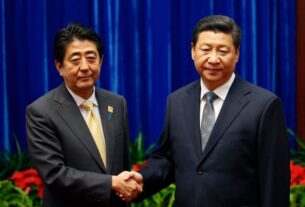Myanmar’s aim to balance between China and India
Since Myanmar is realizing that an increased dependence on China may harm its long term interests in future, there is a growing bonhomie between India and Myanmar to fill the gap which some experts view as an attempt of Yangon to recast the ties with Beijing.
Myanmar is forging closer relations with neighbor India in a radical departure from its recent foreign policy. The move comes as the impoverished Southeast Asian nation attempts to distance itself from its heavy dependence on China.
Recently, in their recent meeting, the leaders of Myanmar and India discussed the construction of roads linking the two countries.
Myanmar’s diplomatic shift away from Beijing towards New Delhi could change the region’s geopolitical balance. It comes at a time when many nations grapple with the challenge of dealing with an increasingly powerful and outwardly assertive China.
Both China and Myanmar have historically an uneasy relationship till 1988, although on the surface it was painted quite colorful and strong. The relationship was trailblazing in other respects.
In the 1950s and 1960s, China considered its relationship with Myanmar as a model for the development of relations with other Asian and African countries and an example of ‘peaceful coexistence’ between socialist and non-socialist states.
In 1954, for example, Myanmar and China affirmed that the Five Principles of Peaceful Coexistence were the guiding principles underlying the development of bilateral relations.
Six years later, China and Myanmar signed the Treaty of Friendship and Mutual Non-Aggression, which stipulated that there should be lasting peace and close friendship between the two sides.
Through the treaty it was meant to have a lifetime of ten-years, China and Myanmar pledged to resolve all disputes through peaceful negotiations and without resorting to force. China subsequently signed treaties of the same name and nature with Afghanistan and Cambodia.
Lack of trust
Only seven years later, however, this “model” relationship began to crumble. The outbreak of anti-Chinese incidents in Yangon in 1967 signaled that not all was well between China and Myanmar.
In reality, throughout the Cold War-even prior to the breakdown of relations between China and Myanmar in 1967-relations were testier than ever publicly acknowledged, and both sides harbored reservations toward one another.
The Chinese, too, were often apprehensive about Myanmar, and Beijing’s “political stance” towards Myanmar was ridden with mistrust.
China characterized independent Myanmar as a nationalist country, one which was “two-faced.” Although Myanmar had revolutionary aspirations against imperialism and colonialism, China believed it also often compromised with the imperialists.
According to the revolutionary theory of the Chinese Communist Party (CCP), the criteria to judge whether a country was socialist or not included the country’s economic and political system, as well as whether it was led by a proletarian revolutionary party and a revolutionary regime.
With Ne Win, the CCP regarded the political leaders of Myanmar as part of the national bourgeoisie. Therefore, Myanmar had the two-faced characteristics of the national bourgeoisie, and were the object of both unity and struggle from the Chinese perspective.
This so-called struggle came in the form of pressure and threats against Myanmar and was meant to prevent it from sliding towards the United States and becoming an anti-communist, anti-China country.
Therefore, in managing relations with Myanmar, China watched all US maneuvers in Myanmar with extraordinary vigilance.
The Chinese were especially concerned about American assistance to Myanmar, including US preparations to help Myanmar build the Yangon-Mandalay Highway.
Similarly, in 1956, Zhou Enlai clearly told (in what can be interpreted as a warning) the Myanmarese Ambassador to China, U Hla Maung, that if Myanmar were to enter into the Southeast Asia Treaty Organization (SEATO), then the two countries would no longer be on friendly terms.
China’s conflicted views of Myanmar did not disappear in the 1960s, even as Myanmar underwent profound political change.
In 1962, after Ne Win’s military government came to power, the CCP believed that the nature of the Myanmarese regime had not changed. They still classified it as “bourgeois centrist.”
The CCP did not recognize “Burmese Way to Socialism” as genuine “socialism.” Nor was China happy with Ne Win’s political and economic measures taken within the country, which weakened Chinese influence and harmed the interests of the Overseas Chinese
Present thinking
Last month, Indian Prime Minister Narendra Modi flew to Naypyitaw. It was the day before this year’s summit of the Association of Southeast Asian Nations began in the Myanmar capital and Modi arrived in the country ahead of all other leaders.
He arrived early to meet Myanmar President Thein Sein, at the request of Myanmar’s government. During their 45-minute talks, the two leaders focused on measures to strengthen the transport connections between their countries, according to an Indian government official.
Specifically, they talked about the development of a network of roads connecting Imphal, a city in northeastern India, with Mandalay, in central Myanmar.
The two countries agreed in 1993 to build a cross-border road, but the plan failed to materialize as Myanmar, battered by Western economic sanctions, was unable to develop its side of the road network.
Seeking to revive and implement the old plan, Myanmar has apparently asked India to help finance the road project. This move reflects a major shift in Myanmar’s diplomatic strategy.
Earlier this year, the country announced plans to triple the level of cross-border trade with India seen in fiscal 2012 by the end of fiscal 2015.
It has also decided to restart exports to India of rice, its main agricultural product, for the first time in four years. Myanmar hopes that the proposed expansion of cross-border transport links will help ramp up its trade.
Modi and Thein Sein also discussed the river port being built in Sittwe in western Myanmar. Indian companies are involved in the construction of the port, which is due to be completed next spring.
The port will create a new distribution network connecting Myanmar with northeastern parts of India via the Kaladan River, which forms part of the border between the two countries.
The new logistics network will contribute to economic development in India’s seven northeastern states, the poorest region of the country.
Another topic at the meeting between the two leaders was the promotion of Indian business investment in the development of Myanmar’s energy resources.
Modi’s decision to skip the summit of the Asian-Pacific Economic Cooperation forum, held in Beijing immediately before the ASEAN conference, for his meeting with Thein Sein reflects the Indian leader’s diplomatic priorities, according to Indian diplomatic sources.
Myanmar’s current efforts to boost ties with India are all the more notable because the two nations have a troubled diplomatic history.
Before World War II, Myanmar was part of the British Indian Empire, and Indians formed the ruling class in the region. Indian companies controlled key industries such as financial services in what is now Myanmar.
After Myanmar gained independence in 1948, anti-Indian sentiment grew in the country, prompting many Indians to leave.
The Southeast Asian nation is now striving to build closer bonds with India mainly because it has decided to reduce its dependency on China, which supported Myanmar while it was ruled by the military junta. During that period, Chinese companies developed dams and built natural gas pipelines in the country.
After taking office in spring 2011, Thein Sein launched reforms to push the country toward democracy and recast the government’s foreign policy to wean the country away from China.
In 2012, Thein Sein froze a dam development sponsored by China Earlier this year, he also scrapped a project for a railway linking Myanmar and China.
Thein Sein’s diplomatic readjustment was accelerated by China’s assertive actions over territorial claims against some ASEAN nations in the South China Sea.
Growing wariness about China’s policy of expansion has pushed Myanmar towards India. Myanmar is now trying to become economically stronger to avoid relying on China’s economic aid.
In recent years, a rift has grown within ASEAN between Cambodia and Laos, which are major recipients of Chinese economic aid, and the Philippines and Vietnam, both embroiled in bitter territorial rows with Beijing.
Myanmar’s bolstering of ties with India could put additional pressure on China to act more peacefully in the region.




